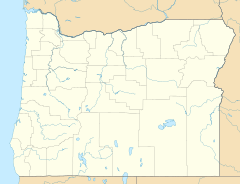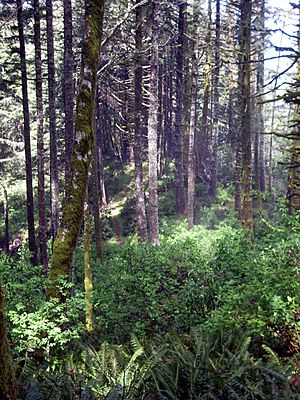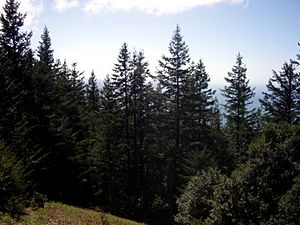Humbug Mountain facts for kids
Quick facts for kids Humbug Mountain |
|
|---|---|
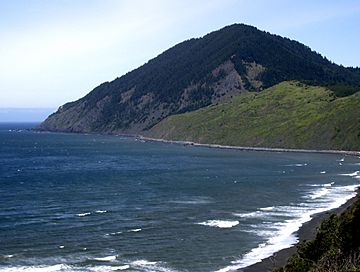
Humbug Mountain, viewed from the south
|
|
| Highest point | |
| Elevation | 1,765 ft (538 m) NAVD 88 |
| Prominence | 1,561 ft (476 m) |
| Geography | |
| Location | Curry County, Oregon, U.S. |
| Parent range | Klamath Mountains |
| Topo map | USGS Port Orford |
| Climbing | |
| Easiest route | Hike |
Humbug Mountain is one of the tallest mountains in the U.S. state of Oregon that rises right from the Pacific Ocean. It is found on Oregon's southern coast. The mountain is about 6 miles (10 km) south of Port Orford. It is also about 21 miles (34 km) north of Gold Beach.
The entire mountain is part of Humbug Mountain State Park. U.S. Route 101 passes right by its northern side. The mountain's slopes are covered in an old-growth temperate rainforest.
Two trails lead from the state park campground to the mountain's summit. One trail is 1.5 miles (2.4 km) long, and the other is 2 miles (3.2 km) long. Both of these trails are part of the much longer Oregon Coast Trail. The area is popular for hikers, campers, cyclists, and whale watchers. However, biking and camping are not allowed on the mountain itself.
Contents
How Humbug Mountain Was Formed
Humbug Mountain was created about 130 million years ago. This was during a time called the early Cretaceous period.
The mountain formed when islands in the Klamath microcontinent crashed into each other. A microcontinent is like a small landmass. This collision pushed up ancient mountains made mostly of sandstone. Over time, old rivers eroded these mountains. The sediment and sandstone were then left on the seashore.
Later, this microcontinent collided with the North American continent. This huge crash pushed up Humbug Mountain. You can still find granite and sandstone rocks near the mountain's top.
Today, Humbug Mountain stands 1,756 feet (535 m) above sea level. It is one of the highest mountains in Oregon that rises directly from the ocean. It is known as a headland. A headland is a piece of land that sticks out into the sea.
The Story of Humbug Mountain's Name
The Tututni people, who are native to the area, originally called Humbug Mountain "Me-tus." When American settlers arrived, they first named it Sugarloaf Mountain.
In 1851, it started to be called "Tichenor's Humbug." This name came from an exploring group sent by Captain William V. Tichenor. He was the founder of Port Orford. This group got lost and went north instead of south of the port. Captain Tichenor said the name was chosen "to palliate their gross failure." This means it was to make their big mistake seem less bad.
Since then, Tichenor's Humbug became known simply as Humbug Mountain. The mountain has also been called Mount Franklin.
In 1934, the Civilian Conservation Corps built the first trail to the mountain's top. However, a big storm called the 1962 Columbus Day Storm destroyed it. People used a different trail until the original one was fixed and reopened in 1993.
Plants and Animals of Humbug Mountain
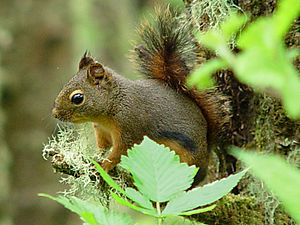
Many kinds of plants grow on Humbug Mountain. Common trees include tanoak, Douglas fir, and big-leaf maple. You can also find Port Orford cedar and Oregon myrtle. Other trees like spruce, alder, and western red cedar also grow there.
Smaller plants are also common. These include maidenhair ferns, wild rhododendrons, and vanilla leaf. In the spring, wildflowers like Columbia lilies, trilliums, and bleeding hearts bloom. Many berries grow on the mountain too. These include currant, elderberries, blackberries, thimbleberries, huckleberries, and salmonberries.
Many animals make Humbug Mountain their home. Birds such as varied thrushes and chickadees live here. Mammals like Douglas squirrels and black-tailed deer are also common.
At the base of the mountain, there are many tide pools in the intertidal zone. This is the area between high and low tides. You can find creatures like jellyfish, littleneck clams, and sunflower starfish in these pools.
Sometimes, Gray whales can be seen migrating along the coast. More rarely, humpback whales are also spotted.
Exploring the Trails
There are several trails on Humbug Mountain. The main Humbug Mountain Trail climbs 1,730 feet (527 m) to the summit. The start of this trail is in the campground at Humbug Mountain State Park.
After going through a tunnel under U.S. Route 101, the trail leads through the old-growth temperate rainforest. The trail has several switchbacks, which are sharp turns that help you climb the mountain.
About 1 mile (1.6 km) into the trail, it splits. The trail to the west was first built in 1934 by the Civilian Conservation Corps. But it was washed out by the Columbus Day Storm in 1962. A different trail was built, which now forms a loop with the original trail. The original trail was rebuilt in 1993.
The original trail is about 1.5 miles (2.4 km) long. The alternate trail is about 2 miles (3.2 km) long. If you hike the full loop, it's about 5.5 miles (8.9 km) round trip. Both of these trails are part of the much longer Oregon Coast Trail.
Another trail starts from the campground. It goes under the highway to a 4-mile (6.4 km) long beach on the north side of the mountain.
A fourth trail is called the Recreation Trail. It follows the path of the Old Coast Highway. This trail is about 2.6 miles (4.2 km) long. It crosses nearby Brush Creek seventeen times. The trail offers many beautiful views of the Pacific Ocean. Eventually, it joins with U.S. Route 101.
Fun Activities at Humbug Mountain
Many fun activities can be enjoyed around Humbug Mountain. These include studying nature, watching wildlife, camping, and whale watching. Hiking and cycling are also very popular on the trails in the area.
You can find beachcombers, windsurfers, and scuba divers on the beach and in the deep water near the mountain.
Humbug Mountain State Park includes all of Humbug Mountain. It has a campground with over 100 campsites. The campground is located between Brush Creek and the beach. It offers amenities like showers, flush toilets, and a special camp for hikers and bikers. There is also an amphitheater. You can find picnic tables in the day-use area, which is 1 mile (1.6 km) south of the main campground.


